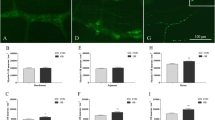Abstract
Adenosine A2B receptors (A2BR) regulate several enteric functions. However, their implication in the pathophysiology of intestinal dysmotility associated with high-fat diet (HFD)-induced obesity has not been elucidated. We investigated the expression of A2BR in mouse colon and their role in the mechanisms underlying the development of enteric dysmotility associated with obesity. Wild-type C57BL/6J mice were fed with HFD (60% kcal from fat) or normocaloric diet (NCD; 18% kcal from fat) for 8 weeks. Colonic A2BR localization was examined by immunofluorescence. The role of A2BR in the control of colonic motility was examined in functional experiments on longitudinal muscle preparations (LMPs). In NCD mice, A2BR were predominantly located in myenteric neurons; in HFD animals, their expression increased throughout the neuromuscular layer. Functionally, the A2BR antagonist MRS1754 enhanced electrically induced NK1-mediated tachykininergic contractions in LMPs from HFD mice, while it was less effective in tissues from NCD mice. The A2B receptor agonist BAY 60-6583 decreased colonic tachykininergic contractions in LMPs, with higher efficacy in preparations from obese mice. Both A2BR ligands did not affect contractions elicited by exogenous substance P. Obesity is related with a condition of colonic inflammation, leading to an increase of A2BR expression. A2BR, modulating the activity of excitatory tachykininergic nerves, participate to the enteric dysmotility associated with obesity.








Similar content being viewed by others
References
Soares A et al (2015) Intestinal and neuronal myenteric adaptations in the small intestine induced by a high-fat diet in mice. BMC Gastroenterol 15:3
Andersen CJ, Murphy KE, Fernandez ML (2016) Impact of obesity and metabolic syndrome on immunity. Adv Nutr 7(1):66–75
Ho W, Spiegel BM (2008) The relationship between obesity and functional gastrointestinal disorders: causation, association, or neither? Gastroenterol Hepatol (N Y) 4(8):572–578
Fysekidis M et al (2012) Prevalence and co-occurrence of upper and lower functional gastrointestinal symptoms in patients eligible for bariatric surgery. Obes Surg 22(3):403–410
Le Pluart D et al (2015) Functional gastrointestinal disorders in 35,447 adults and their association with body mass index. Aliment Pharmacol Ther 41(8):758–767
vd Baan-Slootweg OH et al (2011) Constipation and colonic transit times in children with morbid obesity. J Pediatr Gastroenterol Nutr 52(4):442–445
Bertrand RL et al (2011) A Western diet increases serotonin availability in rat small intestine. Endocrinology 152(1):36–47
Nezami BG et al (2014) MicroRNA 375 mediates palmitate-induced enteric neuronal damage and high-fat diet-induced delayed intestinal transit in mice. Gastroenterology 146(2):473–483 e3
Lam YY et al (2012) Increased gut permeability and microbiota change associate with mesenteric fat inflammation and metabolic dysfunction in diet-induced obese mice. PLoS One 7(3):e34233
Raybould HE (2012) Gut microbiota, epithelial function and derangements in obesity. J Physiol 590(Pt 3):441–446
Stenman LK, Holma R, Korpela R (2012) High-fat-induced intestinal permeability dysfunction associated with altered fecal bile acids. World J Gastroenterol 18(9):923–929
Neunlist M et al (2003) Changes in chemical coding of myenteric neurones in ulcerative colitis. Gut 52(1):84–90
ter Beek WP et al (2007) Substance P receptor expression in patients with inflammatory bowel disease. Determination by three different techniques, i.e., storage phosphor autoradiography, RT-PCR and immunohistochemistry. Neuropeptides 41(5):301–306
Antonioli L et al (2008) Regulation of enteric functions by adenosine: pathophysiological and pharmacological implications. Pharmacol Ther 120(3):233–253
Kadowaki M et al (2000) Molecular identification and pharmacological characterization of adenosine receptors in the guinea-pig colon. Br J Pharmacol 129(5):871–876
Fozard JR, Baur F, Wolber C (2003) Antagonist pharmacology of adenosine A2B receptors from rat, guinea pig and dog. Eur J Pharmacol 475(1–3):79–84
Zizzo MG, Mule F, Serio R (2006) Inhibitory responses to exogenous adenosine in murine proximal and distal colon. Br J Pharmacol 148(7):956–963
Chandrasekharan BP et al (2009) Adenosine 2B receptors (A(2B)AR) on enteric neurons regulate murine distal colonic motility. FASEB J 23(8):2727–2734
Antonioli L et al (2014) Role of the A(2B) receptor-adenosine deaminase complex in colonic dysmotility associated with bowel inflammation in rats. Br J Pharmacol 171(5):1314–1329
Smemo S et al (2014) Obesity-associated variants within FTO form long-range functional connections with IRX3. Nature 507(7492):371–375
Antonioli L et al (2010) The blockade of adenosine deaminase ameliorates chronic experimental colitis through the recruitment of adenosine A2A and A3 receptors. J Pharmacol Exp Ther 335(2):434–442
Erben U et al (2014) A guide to histomorphological evaluation of intestinal inflammation in mouse models. Int J Clin Exp Pathol 7(8):4557–4576
Giron MC et al (2008) Cyclic AMP in rat ileum: evidence for the presence of an extracellular cyclic AMP-adenosine pathway. Gastroenterology 134(4):1116–1126
Zoppellaro C et al (2013) Adenosine-mediated enteric neuromuscular function is affected during herpes simplex virus type 1 infection of rat enteric nervous system. PLoS One 8(8):e72648
Orso G et al (2005) Disease-related phenotypes in a Drosophila model of hereditary spastic paraplegia are ameliorated by treatment with vinblastine. J Clin Invest 115(11):3026–3034
Bradford MM (1976) A rapid and sensitive method for the quantitation of microgram quantities of protein utilizing the principle of protein-dye binding. Anal Biochem 72:248–254
Antonioli L et al (2014) Involvement of the P2X7 purinergic receptor in colonic motor dysfunction associated with bowel inflammation in rats. PLoS One 9(12):e116253
Zizzo MG et al (2011) Adenosine negatively regulates duodenal motility in mice: role of A(1) and A(2A) receptors. Br J Pharmacol 164(6):1580–1589
Antonioli L et al (2010) Control of enteric neuromuscular functions by purinergic A(3) receptors in normal rat distal colon and experimental bowel inflammation. Br J Pharmacol 161(4):856–871
Fredholm BB (2007) Adenosine, an endogenous distress signal, modulates tissue damage and repair. Cell Death Differ 14(7):1315–1323
Hasko G et al (2009) A(2B) adenosine receptors in immunity and inflammation. Trends Immunol 30(6):263–270
Wei W et al (2013) Blocking A2B adenosine receptor alleviates pathogenesis of experimental autoimmune encephalomyelitis via inhibition of IL-6 production and Th17 differentiation. J Immunol 190(1):138–146
Belikoff BG et al (2012) A2B adenosine receptor expression by myeloid cells is proinflammatory in murine allergic-airway inflammation. J Immunol 189(7):3707–3713
Sun CX et al (2006) Role of A2B adenosine receptor signaling in adenosine-dependent pulmonary inflammation and injury. J Clin Invest 116(8):2173–2182
Frick JS et al (2009) Contribution of adenosine A2B receptors to inflammatory parameters of experimental colitis. J Immunol 182(8):4957–4964
Kolachala VL et al (2008) A2B adenosine receptor gene deletion attenuates murine colitis. Gastroenterology 135(3):861–870
Csoka B et al (2014) A2B adenosine receptors prevent insulin resistance by inhibiting adipose tissue inflammation via maintaining alternative macrophage activation. Diabetes 63(3):850–866
Figler RA et al (2011) Links between insulin resistance, adenosine A2B receptors, and inflammatory markers in mice and humans. Diabetes 60(2):669–679
Johnston-Cox H et al (2012) The A2b adenosine receptor modulates glucose homeostasis and obesity. PLoS One 7(7):e40584
Wang CY, Liao JK (2012) A mouse model of diet-induced obesity and insulin resistance. Methods Mol Biol 821:421–433
Kim KA et al (2012) High fat diet-induced gut microbiota exacerbates inflammation and obesity in mice via the TLR4 signaling pathway. PLoS One 7(10):e47713
Laurila A et al (2001) High-fat, high-cholesterol diet increases the incidence of gastritis in LDL receptor-negative mice. Arterioscler Thromb Vasc Biol 21(6):991–996
Kolbus D et al (2010) CD8+ T cell activation predominate early immune responses to hypercholesterolemia in ApoE(−)(/)(−) mice. BMC Immunol 11:58
Khan WI, Collins SM (2006) Gut motor function: immunological control in enteric infection and inflammation. Clin Exp Immunol 143(3):389–397
Margolis KG, Gershon MD (2009) Neuropeptides and inflammatory bowel disease. Curr Opin Gastroenterol 25(6):503–511
Johnson AR, Milner JJ, Makowski L (2012) The inflammation highway: metabolism accelerates inflammatory traffic in obesity. Immunol Rev 249(1):218–238
Ghigliotti G et al (2014) Adipose tissue immune response: novel triggers and consequences for chronic inflammatory conditions. Inflammation 37(4):1337–1353
Bing C (2015) Is interleukin-1beta a culprit in macrophage-adipocyte crosstalk in obesity? Adipocyte 4(2):149–152
Fornai M et al (2014) Role of cyclooxygenase isoforms in the altered excitatory motor pathways of human colon with diverticular disease. Br J Pharmacol 171(15):3728–3740
Kolachala V et al (2005) TNF-alpha upregulates adenosine 2b (A2b) receptor expression and signaling in intestinal epithelial cells: a basis for A2bR overexpression in colitis. Cell Mol Life Sci 62(22):2647–2657
Kolachala V et al (2008) Blockade of adenosine A2B receptors ameliorates murine colitis. Br J Pharmacol 155(1):127–137
Ochoa-Cortes F et al (2016) Enteric glial cells: a new frontier in neurogastroenterology and clinical target for inflammatory bowel diseases. Inflamm Bowel Dis 22(2):433–449
Boison D, Chen JF, Fredholm BB (2010) Adenosine signaling and function in glial cells. Cell Death Differ 17(7):1071–1082
Acknowledgements
This work was supported by grants from San Camillo Hospital, Treviso (Italy), to MCG. The funders had no role in study design, data collection and analysis, decision to publish, or preparation of the manuscript.
Author information
Authors and Affiliations
Contributions
LA, RC, MF, CP, GH, and CB designed the study; ET, DG, MCG, VC, IM, GO, NB, CS, CI, BC, and ZHN collected and analyzed the data; and LA, RC, MF, CS, CP, GH, and CB wrote the manuscript. All of the authors discussed the results and commented on the manuscript.
Corresponding author
Ethics declarations
Conflicts of interest
Luca Antonioli declares that he has no conflict of interest.
Carolina Pellegrini declares that she has no conflict of interest.
Matteo Fornai declares that he has no conflict of interest.
Erika Tirotta declares that she has no conflict of interest.
Daniela Gentile declares that she has no conflict of interest.
Laura Benvenuti declares that she has no conflict of interest.
Maria Cecilia Giron declares that she has no conflict of interest.
Valentina Caputi declares that she has no conflict of interest.
Ilaria Marsilio declares that she has no conflict of interest.
Genny Orso declares that she has no conflict of interest.
Nunzia Bernardini declares that she has no conflict of interest.
Cristina Segnani declares that she has no conflict of interest.
Chiara Ippolito declares that she has no conflict of interest.
Balázs Csóka declares that he has no conflict of interest.
Zoltán H. Németh declares that he has no conflict of interest.
György Haskó declares that he has no conflict of interest.
Carmelo Scarpignato declares that he has no conflict of interest.
Corrado Blandizzi declares that he has no conflict of interest.
Rocchina Colucci declares that she has no conflict of interest.
Ethical approval
The experiments were approved by the Ethical Committee for Animal Experimentation of the University of Pisa and by the Italian Ministry of Health (authorization no. 744/2015-PR).
Electronic supplementary material
Supplemental Fig. 1
Preparations of colonic longitudinal smooth muscle obtained from mice fed with normocaloric diet (NCD) or high-fat diet (HFD) maintained in standard Krebs solution. (A) Effects of increasing concentrations of MRS 1754 (0.001–1 μM) on contractions induced by electrical stimulation (ES, 10 Hz). (B) Effects of MRS 1754 (0.01 μM) on contractile responses to ES in the presence of 1,3-dipropyl-8-cyclopentylxanthine (DPCPX; 0.01 μM), 4-(2-[7-Amino-2-(2-furyl) [1,2,4] triazolo[2,3-a] [1, 3, 5]triazin-5-ylamino]ethyl)phenol (ZM 241385; 0.01 μM) and N-[9-Chloro-2-(2-furanyl)[1,2,4]-triazolo[1,5-c]quinazolin-5-yl]benzene acetamide (MRS 1220; 0.1 μM). Each column represents the mean ± standard error of mean value obtained from six experiments. *P < 0.05 vs control. (GIF 111 kb).
Rights and permissions
About this article
Cite this article
Antonioli, L., Pellegrini, C., Fornai, M. et al. Colonic motor dysfunctions in a mouse model of high-fat diet-induced obesity: an involvement of A2B adenosine receptors. Purinergic Signalling 13, 497–510 (2017). https://doi.org/10.1007/s11302-017-9577-0
Received:
Accepted:
Published:
Issue Date:
DOI: https://doi.org/10.1007/s11302-017-9577-0




